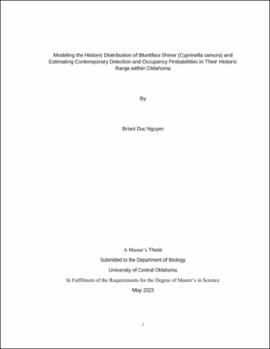| dc.contributor.advisor | Jackson, Victoria | |
| dc.contributor.author | Nguyen, Briant Duc | |
| dc.date.accessioned | 2023-06-26T15:35:24Z | |
| dc.date.available | 2023-06-26T15:35:24Z | |
| dc.date.issued | 2023 | |
| dc.identifier.other | (AlmaMMSId)9982957008902196 | |
| dc.identifier.uri | https://hdl.handle.net/11244/337830 | |
| dc.description.abstract | Bluntface Shiner (Cyprinella camura; BFS) is a fish that is endemic to the Arkansas, Lower- Mississippi, and Tennessee river basins, but exists as disjunct populations east and west of the Lower Mississippi River. Evidence suggests that BFS are experiencing declines across their known range, however the drivers of their decline are mostly unknown and knowledge of life history and habitat requirements of BFS remains limited. We aimed to address these knowledge gaps using species distribution modeling (SDM) and detection and occupancy modeling techniques. In chapter 1, we used SDMs to estimate the historic distribution of BFS across the entirety of its range, identify landscape scale factors which underly their distribution, and compare environmental conditions between the disjunct ranges. Our results revealed a naturally fragmented distribution in either BFS range, and that populations to the east of the Lower-Mississippi occupy streams with broadscale environmental conditions which differ from those to the west. In chapter 2, we focused on the historic distribution of BFS within Oklahoma, and we used a single season occupancy modeling framework while accounting for imperfect detection to estimate contemporary detection and occupancy probabilities for BFS. Our aims were to identify best gears (seine versus backpack electrofishing) for detecting BFS and the environmental conditions which influence gear effectiveness, as well as environmental factors which influence occupancy of the species in wadable streams of their historic range in Oklahoma. We found that detection of BFS varied with gear type depending on environmental conditions present at our sites, but seine produced overall higher detection probabilities. Our occupancy estimates were low despite our search within the historic distribution within Oklahoma. This suggests that BFS are rare and have seemingly declined across large portions of its range. Our findings call for focused conservation and management efforts for BFS across their entire range. | |
| dc.rights | All rights reserved by the author, who has granted UCO Chambers Library the non-exclusive right to share this material in its online repositories. Contact UCO Chambers Library's Digital Initiatives Working Group at diwg@uco.edu for the permission policy on the use, reproduction or distribution of this material. | |
| dc.subject.lcsh | Cyprinidae--Geographical distribution | |
| dc.subject.lcsh | Cyprinidae--Habitat | |
| dc.subject.lcsh | Cyprinidae--Detection--Oklahoma | |
| dc.subject.lcsh | Cyprinidae--Conservation | |
| dc.title | Modeling the historic distribution of bluntface shiner (Cyprinella camura) and estimating contemporary detection and occupancy probabilities in their historic range within Oklahoma | en_US |
| dc.type | Academic theses | |
| dc.contributor.committeeMember | Taylor, Andrew | |
| dc.contributor.committeeMember | Rodger, Anthony | |
| dc.contributor.committeeMember | Messick, Jenna | |
| dc.thesis.degree | M.S., Biology | |
| dc.subject.keywords | Bluntface shiner | |
| dc.subject.keywords | Conservation | |
| dc.subject.keywords | Cyprinella camura | |
| dc.subject.keywords | Detection models | |
| dc.subject.keywords | Species distribution models | |
| dc.subject.keywords | Ecology | |
| dc.subject.keywords | Conservation biology | |
| dc.identifier.oclc | (OCoLC)1385982882 | |
| thesis.degree.grantor | Jackson College of Graduate Studies | |
